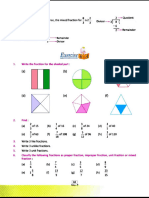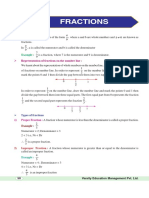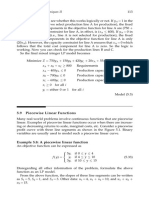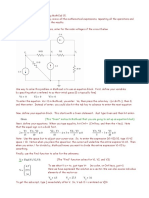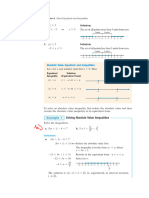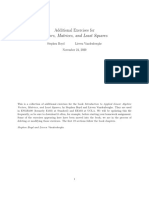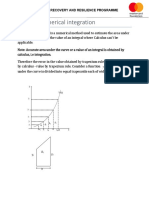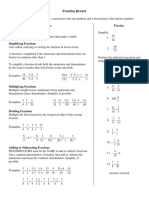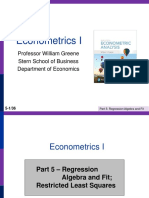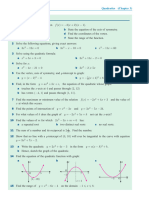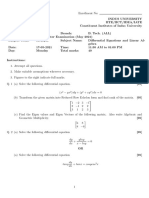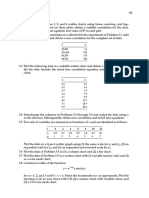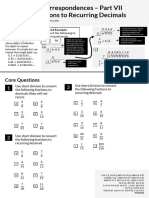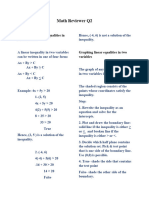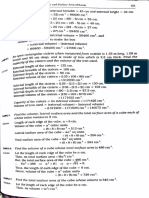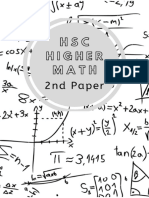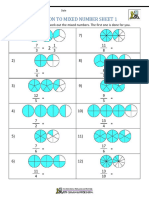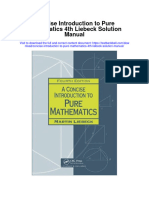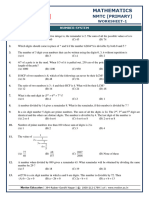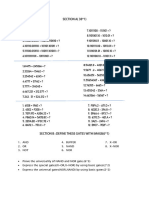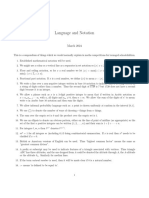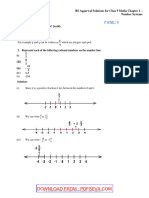HRFH 5 Sfs
HRFH 5 Sfs
Uploaded by
sudip karmakarCopyright:
Available Formats
HRFH 5 Sfs
HRFH 5 Sfs
Uploaded by
sudip karmakarOriginal Title
Copyright
Available Formats
Share this document
Did you find this document useful?
Is this content inappropriate?
Copyright:
Available Formats
HRFH 5 Sfs
HRFH 5 Sfs
Uploaded by
sudip karmakarCopyright:
Available Formats
6 and 8
(0x) 15 are fractions. (x) 24 and are not fractions.
32
3x13+
13 13 (xi) 4
3. From the following tractions, separate (i) proper fractions and (1) improper fractions :
11 20 18 27
20 11' 23' 35
4. Change the following mixed fractions to improper fractions :
(ü) 7 (N) 211
5. Change the following improper fractions to mixed fractions:
100 81 209 113
17 (i) 7 (iv) 15
6. Change the following groups of fractions to like fractions:
2 3 1 5 7 11 2 7 5
3'5' 4 6 () 6' 8 12' 10 (iü) 7' 8' 14' 16
76 REDUCING A FRACTION TO ITS LOWEST TERMS
A fraction is said to be in its lowest tems if its
numerator and denominator have n0
common factor other than 1, ie. the numerator and the denominator are co-prime numbers.
To reduce a fraction to its lowest terms :
() find the H.C.F. of its numerator and
denominator.
(ü) divide each term of the fraction by the H.C.F.
obtained in step (i).
For example :
48
Consider the fraction
60
As the H.C.F.of 48 and 60 is 12, divide both numerator and
denominator by 12.
48 48+12
Thus, 60
which is the fraction in its lowest terms.
60+12 5
45 45+15 3
Similarty, 75 75+15 5
H.C.F. of 45 and 75 is 15
If both the terms of a fraction are divided or multiplied by the same number, the
value of the fraction remains unchanged.
Altermative method:
First express each term of the given fraction as a product of prime factors; then
cancel the common factors.
48 ~xzx2x2x& 2x2
e.g. 60 ZxZ8x5 5 5
8x3x8 3
In the same way, 45 and so on.
75 3x5x5 5
Fractions 69
You might also like
- 3143 01 3RP AFP tcm143-665868Document16 pages3143 01 3RP AFP tcm143-665868nidhiyourmom100% (2)
- Analysis of Hydrocarbon Data - Application of LASSO RegressionDocument26 pagesAnalysis of Hydrocarbon Data - Application of LASSO RegressionAnirban RayNo ratings yet
- 3502maths (1) - 1-10Document10 pages3502maths (1) - 1-10Somen SahaNo ratings yet
- Adobe Scan 07-Nov-2023Document15 pagesAdobe Scan 07-Nov-2023Pari RathodNo ratings yet
- Explanatory Answer: Ratio and ProportionDocument14 pagesExplanatory Answer: Ratio and ProportionArjìt GåútãmNo ratings yet
- Algebra Grade A Revision MatDocument1 pageAlgebra Grade A Revision Matmanobilli30No ratings yet
- 04 FractionsDocument25 pages04 FractionsRupesh RoshanNo ratings yet
- Alg 1 Unit 6 Find The Errors!Document3 pagesAlg 1 Unit 6 Find The Errors!David MassieNo ratings yet
- Fractions ReviewDocument22 pagesFractions Reviewapi-278476928No ratings yet
- RifaiDocument3 pagesRifaiDhani AlmahendraNo ratings yet
- Introduction To MATLAB & Function ManipulationsDocument5 pagesIntroduction To MATLAB & Function ManipulationsNoorLiana MahmudNo ratings yet
- 03 FractionsDocument15 pages03 Fractionsstartrash.ratsNo ratings yet
- Applications of Linear Equations and Graphing: 1. Writing A Linear ModelDocument12 pagesApplications of Linear Equations and Graphing: 1. Writing A Linear ModelGeorgeNo ratings yet
- LESSON 1-ActivityDocument24 pagesLESSON 1-Activityarjay matanguihanNo ratings yet
- Algebra, Relations, Functions and Graphs IIDocument27 pagesAlgebra, Relations, Functions and Graphs IIAnthony Benson100% (2)
- 2 FractionDocument16 pages2 FractionSubrataThakuraNo ratings yet
- Ch4 Notes Transformations 2024Document12 pagesCh4 Notes Transformations 2024Jaspar GlagovsNo ratings yet
- Adobe Scan 01-Sep-2022Document13 pagesAdobe Scan 01-Sep-2022anjanikaushik12No ratings yet
- Multiplication and Division of Rational NumbersDocument7 pagesMultiplication and Division of Rational NumbersAhmet KasabalıNo ratings yet
- This "Given" Instructs Mathcad That You Are Going To Set Up An Equation BlockDocument7 pagesThis "Given" Instructs Mathcad That You Are Going To Set Up An Equation BlockggNo ratings yet
- Math 101 OutlineDocument137 pagesMath 101 Outlineحمد العبرةNo ratings yet
- Class X - Chapter - 1 - Real NumberDocument4 pagesClass X - Chapter - 1 - Real NumberRaghav DagaNo ratings yet
- S03C01 5.5 Teorema Fundamental Del CálculoDocument13 pagesS03C01 5.5 Teorema Fundamental Del Cálculogabriel cervinoNo ratings yet
- 03 Sol 2Document18 pages03 Sol 2Perez CarlosNo ratings yet
- 7) S1 RegressionDocument21 pages7) S1 RegressionPrince YugNo ratings yet
- 5 SolutionDocument5 pages5 SolutionReyansh JainNo ratings yet
- Vmls - 103exercisesDocument50 pagesVmls - 103exercisessalnasuNo ratings yet
- Numerical IntegrationDocument5 pagesNumerical Integrationkaziba stephenNo ratings yet
- Fraction ReviewDocument2 pagesFraction ReviewYoteepp GamezzzNo ratings yet
- Ca t2 M 1208 Grade 5 Fractions Term 2 Test English Canadian - Ver - 3Document11 pagesCa t2 M 1208 Grade 5 Fractions Term 2 Test English Canadian - Ver - 3Puvan FrogAsiaNo ratings yet
- Module 14 Grade 4Document7 pagesModule 14 Grade 4Narelle Bevs GarciaNo ratings yet
- Year 5 Maths Assessment FractionsDocument11 pagesYear 5 Maths Assessment Fractionstlhalatsigao57No ratings yet
- L5 DefuzzificationDocument56 pagesL5 DefuzzificationMadhav ChowdaryNo ratings yet
- INTROMATH moduleWEEk-67Document6 pagesINTROMATH moduleWEEk-67REIANA MITZI M. FernandezNo ratings yet
- ACFrOgA0n-JBWPaiPbblI7BMtbEoIWX5AT3k7lx5 Bx5xgWc-l8JKr5qnsszq7Tzm7rZMDDAODqJ22wLxzzbveQqCGEcnoQUgRpbalB GDL 4yYzXMSEt5Au0DzMmtgp-2WQax7IMfBP6us 1EWKDocument48 pagesACFrOgA0n-JBWPaiPbblI7BMtbEoIWX5AT3k7lx5 Bx5xgWc-l8JKr5qnsszq7Tzm7rZMDDAODqJ22wLxzzbveQqCGEcnoQUgRpbalB GDL 4yYzXMSEt5Au0DzMmtgp-2WQax7IMfBP6us 1EWKCarl Martin EsparraggoNo ratings yet
- Chapter 11 - Regression and Correlation Analysis-2Document10 pagesChapter 11 - Regression and Correlation Analysis-2sthshokoNo ratings yet
- 4.11 HW Machine Learning SOLUTIONDocument2 pages4.11 HW Machine Learning SOLUTIONahihi channelNo ratings yet
- Econometrics I: Professor William Greene Stern School of Business Department of EconomicsDocument36 pagesEconometrics I: Professor William Greene Stern School of Business Department of EconomicsWaleska De Fátima MonteiroNo ratings yet
- Linear Equation and Inequality PDFDocument11 pagesLinear Equation and Inequality PDFMd. Shariful IslamNo ratings yet
- 2 - Hafta CozumlerDocument4 pages2 - Hafta CozumlerHakan YiğitNo ratings yet
- Review Set 3A - Haese Add Maths - 230731 - 075712Document2 pagesReview Set 3A - Haese Add Maths - 230731 - 075712Maurya AdeshraNo ratings yet
- GRE - 2010 2019 - GRE 2019 Sample Question Paper 10Document28 pagesGRE - 2010 2019 - GRE 2019 Sample Question Paper 10Shivam PawarNo ratings yet
- Lecture 2 Polynomial and Rational Functions 2022 StudentDocument67 pagesLecture 2 Polynomial and Rational Functions 2022 Studentn2yjwgppwbNo ratings yet
- Lesson 2 - FractionsDocument15 pagesLesson 2 - Fractionsramil manlunasNo ratings yet
- (Orange Grove Texts Plus) Miklós Bóna, Sergei Shabanov - Concepts in Calculus II-University Press of Florida (2012)Document210 pages(Orange Grove Texts Plus) Miklós Bóna, Sergei Shabanov - Concepts in Calculus II-University Press of Florida (2012)alvarezdiaz_11921176No ratings yet
- Int Math3 Pe 08 PDFDocument62 pagesInt Math3 Pe 08 PDFJereal Trazona Cabaluna Jr.No ratings yet
- Rational and Irrational NumbersDocument14 pagesRational and Irrational Numberssandhya srinivasan100% (1)
- Pec104 Homework4Document4 pagesPec104 Homework4qxz92cdyjbNo ratings yet
- Eco501 Assignment1 Solutions Summer2020Document3 pagesEco501 Assignment1 Solutions Summer2020maruf91100% (1)
- Student Factoring NotesDocument10 pagesStudent Factoring Noteslevisi30No ratings yet
- Higher Engineering Mathematics Bs Grewal-Page25Document1 pageHigher Engineering Mathematics Bs Grewal-Page25Ernie LahaylahayNo ratings yet
- Chapter - 9 Positional Average and Partition ValuesDocument70 pagesChapter - 9 Positional Average and Partition ValuesManpreet Singh Turban CoachNo ratings yet
- Mse Dela Sem 2 May2021Document2 pagesMse Dela Sem 2 May2021krishnanenwani.23.cseNo ratings yet
- Sdruruitut 556Document1 pageSdruruitut 556durrel.designNo ratings yet
- KRKRDocument5 pagesKRKRbertinNo ratings yet
- AllInOne FDP FractionsToRecurringDecimalsDocument1 pageAllInOne FDP FractionsToRecurringDecimalsshopping.clothes64No ratings yet
- Chapter 3 - 3.1to3.3Document45 pagesChapter 3 - 3.1to3.3Ameet Singh SidhuNo ratings yet
- Math Reviewer Q2Document2 pagesMath Reviewer Q2sophieNo ratings yet
- A Brief Introduction to MATLAB: Taken From the Book "MATLAB for Beginners: A Gentle Approach"From EverandA Brief Introduction to MATLAB: Taken From the Book "MATLAB for Beginners: A Gentle Approach"Rating: 2.5 out of 5 stars2.5/5 (2)
- FryhdeyreyDocument1 pageFryhdeyreysudip karmakarNo ratings yet
- Ret 4 y 645 YfhDocument1 pageRet 4 y 645 Yfhsudip karmakarNo ratings yet
- FH Kjhnyl LkrynlklnkglDocument1 pageFH Kjhnyl Lkrynlklnkglsudip karmakarNo ratings yet
- 554 GGTT 55555555Document1 page554 GGTT 55555555sudip karmakarNo ratings yet
- RyryhchhdyDocument1 pageRyryhchhdysudip karmakarNo ratings yet
- RFTGGGGDocument2 pagesRFTGGGGsudip karmakarNo ratings yet
- Maths Soild GTR5wfg1125Document1 pageMaths Soild GTR5wfg1125sudip karmakarNo ratings yet
- WRJFGRGRKL KlethgDocument1 pageWRJFGRGRKL Klethgsudip karmakarNo ratings yet
- CVC Guidelines Combined 11mar2019 PDFDocument278 pagesCVC Guidelines Combined 11mar2019 PDFsudip karmakarNo ratings yet
- Maths Soild GTR5wfg15Document1 pageMaths Soild GTR5wfg15sudip karmakarNo ratings yet
- Qatar - Course I PDFDocument2 pagesQatar - Course I PDFsudip karmakarNo ratings yet
- Maths 1 pt2Document2 pagesMaths 1 pt2sudip karmakarNo ratings yet
- Design Standards 2014 Revision 1Document35 pagesDesign Standards 2014 Revision 1sudip karmakarNo ratings yet
- Interger Operations Notes SheetDocument2 pagesInterger Operations Notes SheetKenneth NewsomeNo ratings yet
- HSC Higher Math Second Paper BOU AAPDocument379 pagesHSC Higher Math Second Paper BOU AAPeeeianemrulNo ratings yet
- Grade-7 Integers WorksheetsDocument5 pagesGrade-7 Integers Worksheetsyahya aliNo ratings yet
- Decimal To Binary TableDocument2 pagesDecimal To Binary Tablemdtanvirkhan1279618No ratings yet
- Quant - Session 3 - Number PropertiesDocument70 pagesQuant - Session 3 - Number PropertiesongwanryanNo ratings yet
- Number ConversionDocument31 pagesNumber ConversionAparna JNo ratings yet
- Number System Sheet - 1Document6 pagesNumber System Sheet - 1PradhumnNo ratings yet
- All Number Systems Questions From CAT Previous Papers PDFDocument59 pagesAll Number Systems Questions From CAT Previous Papers PDFvenkatNo ratings yet
- Mathematics Workbook 1Document168 pagesMathematics Workbook 1Feros FerosNo ratings yet
- Number SystemsDocument20 pagesNumber SystemsThe Twin WolvesNo ratings yet
- Untitled DesignDocument4 pagesUntitled DesignRoginee Del SolNo ratings yet
- Diwali Vacation HomeworkDocument2 pagesDiwali Vacation Homeworkjoshikhushi354No ratings yet
- Latihan Pecahan Tak Wajar Ke No Bercampur - 1 - Tahun 3Document2 pagesLatihan Pecahan Tak Wajar Ke No Bercampur - 1 - Tahun 3Shazuwani Binti RamliNo ratings yet
- 04 Power and RootDocument19 pages04 Power and RootAmit SinghNo ratings yet
- Integer RepresentationDocument34 pagesInteger RepresentationShania HaroldNo ratings yet
- Binomial Theorem PDFDocument8 pagesBinomial Theorem PDFHarshNo ratings yet
- Concise Introduction To Pure Mathematics 4th Liebeck Solution ManualDocument36 pagesConcise Introduction To Pure Mathematics 4th Liebeck Solution Manualemigreinactionfa8bu96% (23)
- NMTC Primary Worksheet-1 Number SystemDocument3 pagesNMTC Primary Worksheet-1 Number SystemRuby khatunNo ratings yet
- 9th Maths - NumberSystemDocument11 pages9th Maths - NumberSystemsai prathyushNo ratings yet
- ICT Question PaperDocument2 pagesICT Question Paperbh0384221No ratings yet
- Integers Worksheet (Grade 6 Maths)Document2 pagesIntegers Worksheet (Grade 6 Maths)Ei MonNo ratings yet
- AIMO Prize - Note On Language and NotationDocument1 pageAIMO Prize - Note On Language and Notationbrucewayne4530No ratings yet
- MU123 Week 3 Unit 3Document13 pagesMU123 Week 3 Unit 3HazemNo ratings yet
- Rational Numbers Index Notebook WorkDocument3 pagesRational Numbers Index Notebook WorknahNo ratings yet
- 1st Lecture - Number - System, IEEE754Document51 pages1st Lecture - Number - System, IEEE754arshpreetmundra14No ratings yet
- RS Aggarwal Class 9 Chapter 1Document7 pagesRS Aggarwal Class 9 Chapter 1anuradhadevi080100% (3)
- 6-7 - Rational - NumbersDocument76 pages6-7 - Rational - NumbersDavid QianNo ratings yet
- 2 DLL Aquino Jamaica Aquino Q1 G7Document10 pages2 DLL Aquino Jamaica Aquino Q1 G7Jamaica Ikan AquinoNo ratings yet
- Cds Maths MockDocument7 pagesCds Maths Mockmanansinghrathore2004No ratings yet
- Grade 5 Fractions To Decimals BDocument2 pagesGrade 5 Fractions To Decimals Bh5j5pt4mkwNo ratings yet



